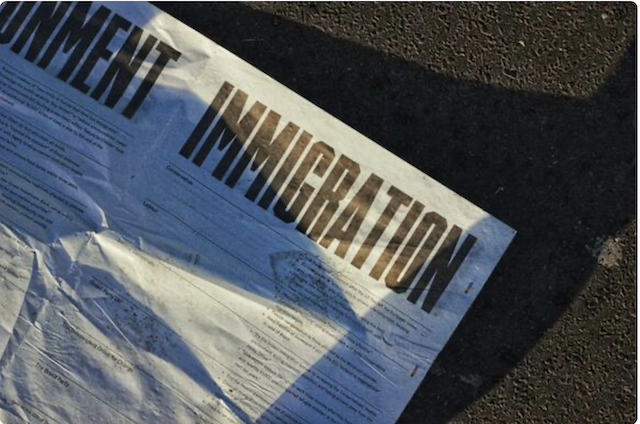~ Introduction ~
There are statements being made in this column which may be offensive and upsetting to some of our readers. Do NOT let them offend, for in the end – this is a history lesson – and there is MUCH stated below that is well worth consideration. ~ Jeffrey Bennett, Editor

Legal Immigrants, Illegal Immigrant, Refuge there is a difference. (AlamogordoTownNews.com)Photo by Metin Ozer on Unsplash
Mr. Trump and the GOP has made concerns about illegal immigration the issue of the campaign. The focus is on the southern border and the huge number of arrivals. The rhetoric has placed those legal immigrants and those legal refugees as targets to harassment, slander and violence. The glares and stares of being dark skinned and speaking another language as a first language adds to the anxiety each “legal” faces daily along with institutionalized barriers to assimilation.
This article clarifies some facts on legal, illegal immigration and on the status called refugee.
~ History ~
The United States has a long history with immigration, with the vast majority of the current population coming from some form of immigrant background. All citizens of the United States other than those who are American Indian or Alaska Native are a product of immigration. A great number. The economic strength of the United States, alongside the mammoth degree of soft power possessed by the country, means that demand for so-called ‘green cards’ (permanent residence visas) is high. Since 2007, the United States has approved around one million green cards per year, although this number fell slightly in 2020 and 2021 as a result of the COVID-19 pandemic. The greatest number of permanent residency approvals in 2021 were for persons residing in California.
As per History.com, the history of immigration begins with an institutionalized tone of preference for “white individuals,” congress passed the first law about who should be granted U.S. citizenship. The Naturalization Act of 1790 allows any free white person of “good character,” who has been living in the United States for two years or longer, to apply for citizenship. Without citizenship, non-white residents are denied basic constitutional protections, including the right to vote, own property, or testify in court. The earliest immigration law excluded Native Americans, indentured servants, enslaved people, free Africans, Pacific Islanders, and non-White Asians. In reading the Naturalization Act, the courts also associated whiteness with Christianity and thus excluded Muslim immigrants from citizenship until the decision Ex Parte Mohriez recognized citizenship for a Saudi Muslim man in 1944.
Congress modelled the Act on the Plantation Act 1740 of the British Parliament (13 Geo. 2 c.7) that was officially titled An Act for Naturalizing such foreign Protestants and others therein mentioned, as are settled or shall settle in any of His Majesty’s Colonies in America, and used its provisions concerning time, oath of allegiance, the process of swearing before a judge, etc.
The English are the largest ethnic group among the 3.9 million people counted, though nearly one in five Americans are of African heritage as of the first census.
Immigration doubled the American population over the next few decades.
Between 1820 and 1860, the Irish, many of them Catholic account for an estimated one-third of all immigrants to the United States. Some 5 million German immigrants also come to the United States, many of them making their way to the Midwest to buy farms or settle in cities including Milwaukee, St. Louis and Cincinnati. By today’s standards over half might be considered illegal as they were stowaways and added to many ships bound for the United States.
During this period many of newcomers arrive sick or dying from their long journey across the Atlantic in cramped conditions. The immigrants overwhelm major port cities, including New York City, Boston, Philadelphia and Charleston. In response, the United States passes the Steerage Act of 1819 requiring better conditions on ships arriving to the country. The Act also calls for ship captains to submit demographic information on passengers, creating the first federal records on the ethnic composition of immigrants to the United States.
America’s first anti-immigrant political party, the Know-Nothing Party forms, as a backlash to the increasing number of German and Irish immigrants settling in the United States.
The “Know Nothing Party,” opposed to immigrants and Catholics, the Know Nothings used the beliefs of white Christian supremacy to seize political power over minority populations. A very similar tone coming from Trumpian ideology today.
Note to Texas Governor Abbott: following the Civil War, some states passed their own immigration laws. In 1875 the Supreme Court in CHY LUNG V. FREEMAN (1875) declares that it’s the responsibility of the federal government to make and enforce immigration laws.
NOTE: ...and THAT is the problem. The united States government is NOT doing their job. ~ Editor
Between 1880 and 1920, more than 20 million immigrants arrive including 2 million Jews.
The Chinese Exclusion Act passed, which prevented legal Chinese immigrants from entering the United States. Many illegals continued.

Circa 1952, a group of 171 “illegal aliens” wave goodbye to the Statue of Liberty from the Coast Guard cutter that took them from Ellis Island to the Home Lines ship ‘Argentina’ in Hoboken for deportation. – Photo by Buyenlarge/Getty Images)
It was not until January 1892 when Ellis Island opened as the United States’ first immigration station, opening in the New York Harbor.
In 1910, an estimated three-quarters of New York City’s population consists of new immigrants and first-generation Americans. (Can you imagine and American city today in 2024 with 3/4 of the population as new immigrants?)
Per History.com, the Immigration Act of 1924 limits the number of immigrants allowed into the United States yearly through nationality quotas. Under the new quota system, the United States issues immigration visas to 2 percent of the total number of people of each nationality in the United States at the 1890 census. The law favors immigration from Northern and Western European countries. Just three countries, Great Britain, Ireland and Germany account for 70 percent of all available visas. Immigration from Southern, Central and Eastern Europe was limited. The Act completely excludes immigrants from Asia, aside from the Philippines, at the time an American colony.
The deep roots of immigration from Mexico and the western hemisphere relates back to World War 2. 1942: Labor shortages during World War II prompt the United States and Mexico to form the Bracero Program, which allows Mexican agricultural workers to enter the United States temporarily. The program lasts until 1964.
In 1986, Republican President Ronald Reagan issues amnesty to illegals within the United States. President Ronald Reagan signed into law the Simpson-Mazzoli Act, which granted amnesty to more than 3 million immigrants making them legal in the United States.
Immigration is a divisive political issue.
Although 68 percent of Americans thought that immigration was a good thing for the United States as of 2023, this number has decreased over the last few years. A survey found that Americans were more likely to say that they are dissatisfied with the level of immigration into the U.S., with the majority agreeing that immigration into the U.S. should be decreased in the future. At the center of this public debate is illegal immigration and the fear of the influx via the southern border.
Illegal immigration is not the only immigration source to have been brought into the political discourse in recent years. The refugee policies of the United States have also been questioned by both members of the public and political leaders. Despite the intense degree of vetting required to successfully obtain refugee status in the U.S., there is still a large amount of refugees, people who have been forced to leave their country due to dangerous circumstances, entering the United States on a regular basis. During the fiscal year of 2022, there were almost 8,000 refugees from the Democratic Republic of Congo alone.
Per Statista.com, the acceptance of refugees has been a tense topic in the U.S. for as long as it’s been an issue. However, recent conflicts in Europe have presented a potential change in the hearts of Americans. According to a survey conducted in 2022, the majority of Americans were found to believe that Ukrainian refugees should be accepted in the U.S. Since the Russian invasion of Ukraine in February of 2022, the U.S. has welcomed over 2,000 Ukrainian refugees and committed itself to welcoming even more, which may further represent a change in past opinion and a new hope for those fleeing violence. However, around one third of Americans were still in opposition of ‘admitting thousands of Ukrainian refugees’, making it uncertain whether support for refugees will continue in the future.
Ukraine has now become a divided issue with a small element within the GOP and former president Trump speaking against support of Ukraine and leaning into Putin and the Russian cause. This rhetoric has caused a backlash in attitudes toward Ukrainian immigration.
What is an immigrant (legal and illegal) and a refugee?
A Legal Immigrant is an immigrant or someone who chooses to resettle to the United States via legal means. The United States has a legal process for that immigrant to seek legal residency and eventually citizenship.
An Illegal immigrant is one of those that have overstayed their work visas, came in via the various ports or border, crossed the border, flew in as vacationers and stay and have not applied for the legal process of becoming an immigrant. There are 11 million undocumented immigrants in the United States a problem that has led Democrats and Republicans alike to declare the U.S. immigration system as “broken.” Congress has been deadlocked for years on how to reform immigration laws, a reform measure was agreed upon by this Congress, but Trump nixed it via a small group of his supporters in the house, not wanted Biden to get credit for fixing the issue.
A Refugee is someone who has been forced to flee his or her home country. As such, refugees can apply for asylum in the United States, a process that could take years. Getting refugee status isn’t easy.
The applicants have to prove that if they return to their home country, they’ll be injured because of their race, religion, nationality, membership in a particular social group or their political opinion.
“Refugees are generally people outside of their country who are unable or unwilling to return home because they fear serious harm,” the U.S. Citizenship and Immigration Services says.
Presently the Central Americans overwhelming the U.S. and Mexican border are Hondurans, Guatemalans and Salvadorans. Many are fleeing drug and gang fuelled violence back home thus seeking refugee status.
Humanity is the issue:
Immigration is the foundation of the economic and political success of the United States. Unless one is a Native American then you are a beneficiary of America’s immigration policies. Immigration should not be a divisive political issue but an issue of dialogue and debate for solutions with respect to the humanity behind the issue.
The topic should never be weaponized for political points as it has been in this presidential and congressional election.
This issue impacts humanity and the soul of the United States.
Written for and Published by the Alamogordo Conservative Daily ~ February 23, 2024
